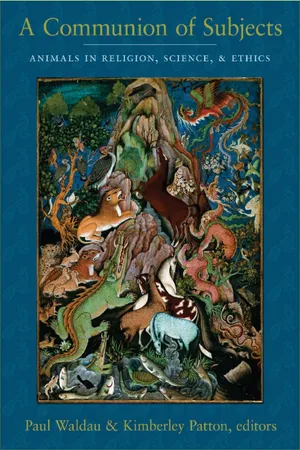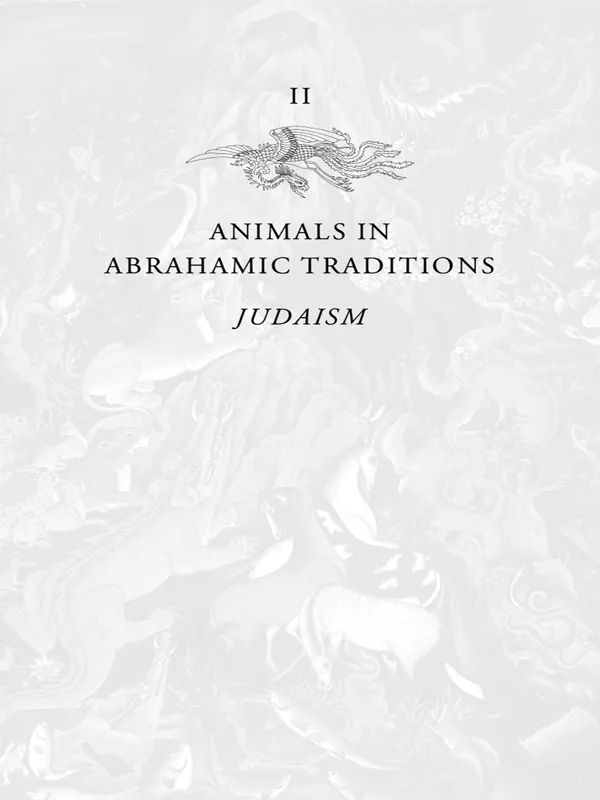![]()
![]()
Sacrifice in Ancient Israel
Pure Bodies, Domesticated Animals, and the Divine Shepherd
JONATHAN KLAWANS
An analysis of biblical sacrifice holds promise for elucidating ancient Israelite attitudes toward animals in general and toward especially those animal species that were considered most fit for sacrifice: sheep, goats, and cattle (Leviticus 1:2). But understanding sacrifice in ancient Israel is a problematic endeavor, for a good deal of what has been written on biblical sacrifice has been influenced by undue and imbalanced hostility toward a ritual that means much more than most are willing to grant.
One challenge raised by sacrifice in general is a moral one–or so it is thought. A number of theoretical works on sacrifice operate on the assumption that there is some direct relationship between the practice of sacrifice and the human proclivity for violence.1 For such theorists, figuring out how sacrifice began allows one to understand the origin of human violence too. The first step toward appreciating what sacrifice means within any specific religious system, however, is to reject this approach outright. If sacrifice poses an ethical problem, it is because animals are killed in the process. Yet the (incomplete) elimination of ritual sacrifice from (most) contemporary religious practice has done no good for the animals. Whoever feels smug about the elimination of sacrificial altars can just visit a slaughterhouse or a laboratory: neither is a more welcome place for an animal than an ancient temple.2 The elimination of sacrifice is not an ethical development, but an aesthetic one. The only real advance here is one of differentiation:3 Where premoderns worshipped and consumed animals in a single process, moderns have divided the two activities by the short distance and time that separates our places of religious assembly from our refrigerators.
The imbalanced moral disgust (that scholars often don’t bother to conceal) toward sacrifice in general finds two accomplices in the religious agendas of many who set out to study sacrifice in ancient Israel in particular. Christian theology predicates itself on the idea that the self-sacrifice of God’s son supersedes the presumably flawed system of ancient Israelite ritual sacrifice that preceded it. Such theological suppositions are by no means absent from works on ancient Israelite sacrifice or early Christian ritual.4 But religious opposition to ancient Israelite sacrifice is not distinctively Christian. It is less well known but no less significant that the movements of Judaism that advocate modernizing reforms (Reform, Conservative, Reconstructionist) assert with an equal determination that animal sacrifice will remain a thing of the past.5 Because the history of modern Jewish historical scholarship is intertwined with the history of synagogue reform (in figures such as Abraham Geiger6) we should not be surprised that a good deal of Jewish scholarship on the Hebrew Bible or ancient Judaism operates on the assumption that sacrifice was hopelessly outmoded and meaningless.7 While the (modernist) Jewish8 and Christian presuppositions differ to no small extent, what they share is the common idea that biblical sacrifice is–and, by implication, always was–a morally and spiritually incomplete ritual. Because a great deal of scholarship on the Bible is carried out by those who operate with one of these perspectives (the present author included) it is no coincidence that sacrifice is often treated with disdain and disgust.
How then to approach sacrifice? Paradoxically, part of the problem has been that scholars have set their scopes, at the same time, too narrowly and too broadly. When setting out to study sacrifice in ancient Israel, there is no need to consider either where sacrifice came from or what finally happened to it. Sacrifice was an unquestioned given in the biblical world.9 Modern scholarly concerns with how sacrifice came about in the first place or why sacrifice seems to have disappeared should be set aside. These questions are at best irrelevant to the task at hand: we cannot necessarily understand what something represents in one context by understanding how it began in some earlier era or what later happened to it closer to our own day. Too often, though, the analysis of sacrifice in ancient Israel is driven by a desire to answer these questions. When one sees Israelite sacrifice as either a vestige of things past or as sign of things to come, one can hardly understand sacrifice for what it is. Our scope is more narrow: we will remain focused on sacrifice in ancient Israel.
In a different way, however, the study of ancient Israelite sacrifice has been too confined. The analysis of sacrifice too frequently focuses exclusively on the killing of an animal, which actually constitutes only one step of a ritual process that is much broader. To understand sacrifice we must understand more than what it means to spill blood. We must endeavor to understand what it means to purify oneself for sacrifice, to own animals fit for sacrifice, and to select from among them a single sacrificial offering. What is more, we must understand what it means not only to kill the animal, but also to dissect it, to consume some parts of it and to burn other parts on the altar. As Victor Turner advised some time ago, sacrifice is to be understood as a process with several stages.10 Turner was following Henri Hubert and Marcel Mauss, who devoted part of their classic 1898 essay to describing the processes of “sacralization” and purification that precede sacrifice.11 This is the scope that must be widened: instead of focusing on the single element of sacrifice that causes us the most trouble, we must try to imagine the entire process of sacrifice, as an ancient Israelite experienced it.
In what follows, we will trace a number of facets of the ancient Israelite sacrificial process, and we will present a symbolic framework for tying many of these aspects together. We remain, for the present purposes, focused on ancient Israelite animal sacrifice, even though Israelite sacrificial worship did not always involve animals.12 Moreover, for the present purposes, we are concerned with sacrifice in general, and will not distinguish between the disparate forms and contexts of distinct ancient Israelite sacrificial offerings.13
As we retrace and rethink the general contours of the ancient Israelite sacrificial process (broadly defined), we will do well to think of animals as subjects, and not as objects. Some are likely to assume that because Israelites performed animal sacrifice, they must have despised or at least objectified the animals they offered. We will proceed with a different assumption: in order to understand what it meant for them to sacrifice, we must first understand what it meant for them to act as their animals’ shepherds. As we will see, the Hebrew Bible presents a good deal of evidence that the necessary preliminaries of sacrificial acts–including, especially, shepherding–had profound theological connotations. Therefore, to trace Israel’s sacrificial process–and to grasp fully its symbolic meanings–we will also need to appreciate better Israel’s relationship with its animal subjects.
Ritual Purity and Imitatio Dei
For ancient Israel, the sacrificial process can be said to begin with ritual purification. Ritual purity is the prerequisite of those who come to the sanctuary to offer sacrifices, of those who regularly officiate at sacrifices (priests), and of any animals that are to be offered as sacrifices. The relation between ritual purity and sacrifice is underscored in Scripture: laws concerning both are juxtaposed in the text of Leviticus.14
Ritual purity can be defined as being in a state free from ritual impurity. Ritual impurity results from direct or indirect contact with any one of a number of natural sources including childbirth (Leviticus 12:1–8), certain skin diseases (13:1-46; 14:1-32), fungi in clothes and houses (13:47-59; 14:33-53), genital discharges (15:1-33), the carcasses of certain impure animals (11:1-47), and human corpses (Numbers 19:10-22). Ritual impurity also comes about, paradoxically, as a byproduct of certain purificatory procedures (e.g., Leviticus 16:28; Numbers 19:8).15 The durations of these impurities differ, as do the requisite cleansing processes–but the intricacies of these laws are not our concern at this moment. What is our concern is the fact that these impurities convey an impermanent contagion, which prevents all who are ritually impure from coming into contact with the sacred. In order to bring an offering to a sacred altar, one must be ritually pure.
A number of theories have been advanced in the attempt to account for the varied nature of the substances viewed as ritually defiling in Leviticus 11-15 and Numbers 19. One popular theory focuses on death as the common denominator of the ritual purity system. The most articulate champion of this view currently is Jacob Milgrom, who, after reviewing the sources of ritual defilement, states:16
The common denominator here is death. Vaginal blood and semen represent the forces of life; their loss–death. … In the case of scale disease [i.e., “leprosy”], this symbolism is made explicitly: Aaron prays for his stricken sister, “Let her not be like a corpse” (Numbers 12:12). Furthermore, scale disease is powerful enough to contaminate by overhang, and it is no accident that it shares this feature with the corpse (Numbers 19:14). The wasting of the body, the common characteristic of all biblically impure skin diseases, symbolizes the death process as much as the loss of blood and semen.
The importance of death as a common denominator of the avoidance regulations in priestly traditions can also be seen, perhaps, in the blood prohibition (Leviticus 17:10-14), in the elimination of carnivores from the diet of ancient Israel, and in the abhorrence of pigs, which played a role in Canaanite chthonic (underworld) worship.17 The purpose of the system, as Milgrom elsewhere states, is to drive a wedge between the forces of death, which are impure, and the forces of life, which like God are holy.18
This impurity-as-death “theory”–we could just as well call it a metaphor (see below)–is by no means entirely new, and Milgrom notes that other scholars have focused on death in order to understand ritual impurity in ancient Israel.19 This view finds partial corroboration in the fact that death is problematized in other purity systems, such as those of the Zoroastrians and the Greeks.20 Yet the view of death as impure and corpses as defiling is by no means universal: some societies concerned with defilement problematize death, while others do not.21 Just as there are no universal taboos, so too there is no universal theory of impurity.
While few scholars deny the importance of death-avoidance to the biblical purity system, some questions remain. One question concerns the relationship between death-avoidance and sex-avoidance. A second question concerns sacrifice. Indeed, the centrality of death to the ritual purity system brings us to a riddle at the heart of our concerns. Why, if the ritual purity system is concerned with keeping death out of the sanctuary, does the sacrificial system involve precisely the opposite: the killing of animals, in the sanctuary?22
Regarding the relationship between death and sex, the death-avoidance theory may well explain why individuals become ritually defiled when genital fluids are lost through nonsexual discharge from the body–surely the potential for life is lost in such situations. But it remains unclear whether or not the fear of death really explains why sex and birth always defile, even when no mishap occurs. Moreover, why is i...


